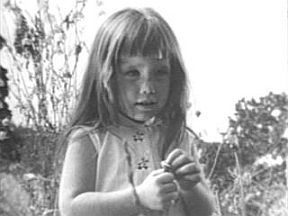On September 7, 1964, television advertising history was made during the broadcast of NBC’s Monday Night at The Movies. That’s when a new kind of TV ad was first aired that would forever change the art and practice of political advertising – and to a large degree, political campaigning as well. For 1964 was the year that the negative political ad was born, initiating the clever use of image and sound to paint an opponent in negative or scary terms. No less than a presidential election was at stake.
The Democrats, with President Lyndon B. Johnson in the White House following the assassination of John F. Kennedy, were headed for an election-year battle with Republican presidential candidate Barry Goldwater, a fierce and outspoken conservative. The Democrats had hired a New York advertising firm to help them in their campaign. Among the ad men enlisted was Tony Schwartz who believed that negative impressions associated with a particular candidate could be more powerful in persuading voters than positive ones.
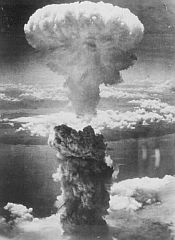
Photograph of an atomic blast, a version of which was also shown in the 'Daisy Girl' campaign ad.
On the campaign trail, Goldwater had advocated the use of “tactical” nuclear weapons in Vietnam, and Lyndon Johnson’s team seized upon that statement, determined to paint Goldwater as dangerous. One result was the infamous “Daisy Girl” TV ad, a one-minute spot featuring a little blond girl in an open field, appearing innocent and playful, plucking petals off a daisy. She is heard in a sweet voice counting her numbers as she removes each petal, flubbing the sequence a bit, as young children do: “One, two, three, four, five, seven, six, six, eight, nine, nine…,” she says, counting in a slow, sing-song fashion. Immediately following the little girl’s voice comes a man’s voice, enhanced by an echo chamber. The girl looks up from her depetaled flower, as if hearing the distant voice, now counting backwards: “Ten, nine, eight, seven, six, five, four, three, two, one, zero.” The sound of a horrific explosion follows as the TV image changes sharply to the mushroom cloud of an atomic explosion, then an x-ray image of the Daisy Girl as the blast sound rolls out for an extended count of some long seconds. Then comes the voice of President Lyndon B. Johnson. In his perfect Texas twang, pausing purposely for effect at the proper moments, Johnson makes his plea: “These are the stakes,” he says. “To make a world in which all of God’s children can live… Or, to go into the darkness… We must either love each other, or we must die.” The piece closes with an announcer voice-over: “Vote for President Johnson on November 3rd. The stakes are too high for you to stay home.”
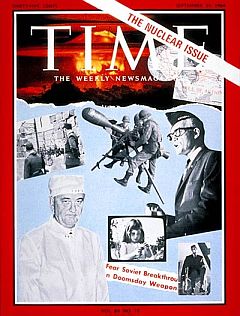
'Daisy Girl' TV clip shown on the lower portion of Time magazine's cover, September 25, 1964, in a featured story on 'The Nuclear Issue'.
Goldwater & Nukes
The implied message of the ad was crystal clear for anybody remotely following the election that year: Goldwater was not to be trusted with nuclear weapons, and if elected, he would surely unleash a nuclear showdown. In fact, the Republican National Committee noted in reply: “This ad implies that Senator Goldwater is a reckless man and Lyndon Johnson is a careful man.”
The Daisy Girl ad, in any case, created such a furor that it was withdrawn after being shown only once, during the NBC Movie that September 7th. But all the controversy led to its being replayed many times more, in its entirety, including on network newscasts at ABC and CBS, commentary programs, and displayed in news magazines. It also appeared as part of a montage of images on the cover of Time magazine’s September 24th, 1964 issue, featuring “The Nuclear Issue” as its cover story.
“Daisy Girl” changed the politics of advertising from that moment on. Goldwater’s campaign followed with its own scary ad, titled, “We Will Bury You,” using a scene of young American school students reciting the Pledge of Allegiance juxtaposed with Soviet leader Nikita Khrushchev making his famous threatening United Nations speech in which he invoked that phrase and another, saying, “Your children will be communists.”
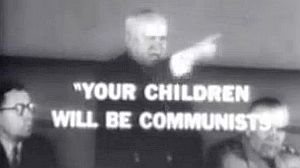
Goldwater’s response ad to the Democrats was to suggest that Nikita Khrushchev & the communists were on their way.
“I want American kids to grow up as Americans. And they will, if we have the guts to make our intentions clear. So clear they don’t need translation or interpretation, just respect for a country prepared, as no country in all history ever was.” Then a narrator’s voice adds: “In your heart, you know he is right [which had become a Goldwater slogan by then]. Vote for Barry Goldwater.”
Presidential elections up until 1964 often used simple campaign songs, jingles, and images, as Kennedy and Eisenhower had done in the 1950s and in 1960, or used only rudimentary and fairly crude ads in the early years of television. But it was President Kennedy in the summer of 1963, then contemplating his own re-election campaign, who had first decided to use the New York group that would prepare the “Daisy Girl” ad. Doyle Dane Bernbach, known as DDB in the trade, was the firm Kennedy had selected. He had been impressed by the modern approach of DDB’s Volkswagen “Think Small” ads, and the Avis “We Try Harder”campaign.
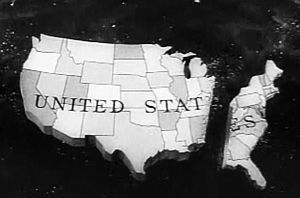
Another LBJ campaign ad critical of Goldwater used a simple visual of the Eastern U.S. being “sawed off” the U.S. map, referring to a Goldwater statement.
Barry Goldwater was furious over the Daisy Girl ad, and he called Johnson at the White House to tell him so. But Goldwater, in fact, was his own worst enemy, as it was his own statements that were often used by Johnson’s team and DDB to make other Goldwater ads.
“We took his words and made commercials out of them,” explained Sid Myers, the DDB senior art director who had worked on the Daisy Girl ad and others. “Like when he said the United States would be better off if we sawed off the Eastern Seaboard and let it float out to sea. Well, we visually did that line [with a TV ad] and it was very, very effective.”
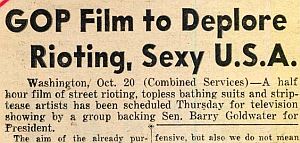
October 21, 1964: Headlines from the New York Daily News describing a film from Barry Goldwater supporters featuring a Democrat-fueled morals crisis.
Goldwater Film
The advertising wars between Goldwater and Johnson had started prior to the Daisy Girl ad, and the battling between the two camps continued thereafter, leading up to the November election. In fact, at one point, some of Goldwater’s team were preparing to escalate the negative campaigning with their own special project. A half-hour film entitled “Choice” had been produced. That Republican/Goldwater campaign film set out to grab the high ground on U.S. morality by suggesting that the Democrats and Lyndon Johnson were the source of a national morals decline, charging that a descent into riots, “sex parties,” and debauchery of all imaginable kind was then underway. One summary of the film describes it as follows:

Oct 1964: Mock-up ad drafted for the “Choice.”
…[T]his film shows what purports to be the two Americas: One is traditional, moral, and conservative, represented by fields of grain, skyscrapers, construction workers, and smiling children. The other is about race riots, permissiveness, strippers, gambling dens, and roadhouses. The incumbent Johnson administration is symbolized over and over by a Lincoln Continental roaring recklessly down a dirt road. The brainchild of Goldwater’s campaign manager F. Clifton White, the film’s formula of juxtaposing contrasting imagery comparing the two candidates would become the standard for political shorts and campaign ads…
However, just before the scheduled TV broadcast of the “Choice,” word of the project leaked out in the press with a round of embarrassing headlines. Goldwater, although he had approved the making of the film, then cited some racist rioting content in the film and disowned it. The film was then withdrawn before its scheduled TV broadcast.
Still, the resulting headlines and controversy that swirled around the “Choice” film and its cancellation was just as big if not bigger that the flap over Johnson’s Daisy Girl ad. “Furor on Barry Film” said one headline from the Citizen-News of the Beverly Hills on October 21, 1964. “Film on Morals Held Up By Barry,” announced big, bold headlines on the front page of the Los Angeles Times, October 22, 1964.
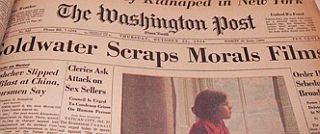
October 22nd, 1964: Front-page headline of the Washington Post tells of Republican Presidential candidate Barry Goldwater abandoning plans to broadcast a morals film.
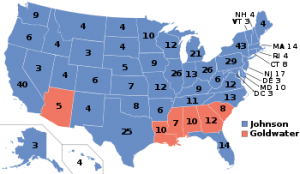
November 1964: U.S. map showing the results of that year’s Presidential Election -- “Lyndon’s Landslide.”
For additional stories at this website related to politics, please visit the “Politics” category page, or visit the “Madison Avenue” page for story choices related to advertising and marketing.
Thanks for visiting — and if you like what you find here, please make a donation to help support the research and writing at this website. Thank you. –Jack Doyle
|
Please Support Thank You |
________________________
Date Posted: 15 April 2008
Last Update: 7 March 2019
Comments to: jdoyle@pophistorydig.com
Article Citation:
Jack Doyle, “LBJ’s Atomic Ad,” PopHistory
Dig.com, April 15, 2008.
_____________________________
Sources, Links & Additional Information
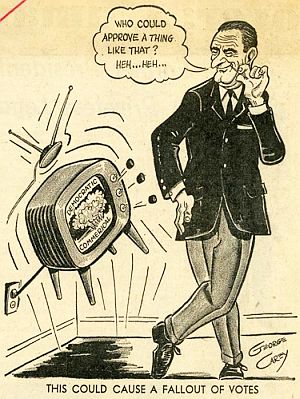
October 20, 1964: Editorial cartoon on LBJ’s Daisy Girl TV ad by George Carey of the “Valley Times” (Los Angeles), made during the Goldwater morals film flap.
John D. Morris, “Parties Sign Fair-Play Pledge, Then Wrangle Over Johnson Ad, New York Times, Saturday, September 12, 1964, p.10.
Nan Robertson, “Johnson and Goldwater Open Television Campaigns, With Both Planning Big Outlays,” New York Times, Tuesday, September 15, 1964, p. 18.
“The Fear & The Facts,” Nuclear Issue cover story, Time, Friday, September 25, 1964.
Pete Hamill, “When the Client Is a Candidate, New York Times Sunday Magazine, October 25, 1964, p. 30.
“Daisy” (TV advertisement), Wikipedia.org.
For an exhaustive treatment of the history and politics behind the “Daisy Girl” ad, see:”Daisy: the Complete History of an Infamous and Iconic Ad,” Conelrad.com.
“Choice (1964): The Scrapbook,” Conelrad, October 13, 2010.
Robert Mann, Daisy Petals and Mushroom Clouds: LBJ, Barry Goldwater, and the Ad That Changed American Politics, Louisiana State University Press, November 2011, 179pp.
“2012 Campaign Ads Owe Debt To ‘Daisy Petals’,” NPR.org, December 14, 2011.
Robert Mann, “Goldwater and Romney Each Had a “47 Percent” Moment,” BobMannBlog.com, September 19, 2012.
“Choice” [1964 Barry Goldwater Campaign Film], YouTube.com.
Dan Nowicki, The Arizona Republic, “’Daisy Girl’ Political Ad Still Haunting 50 Years Later,” USAToday.com, September 7, 2014.
